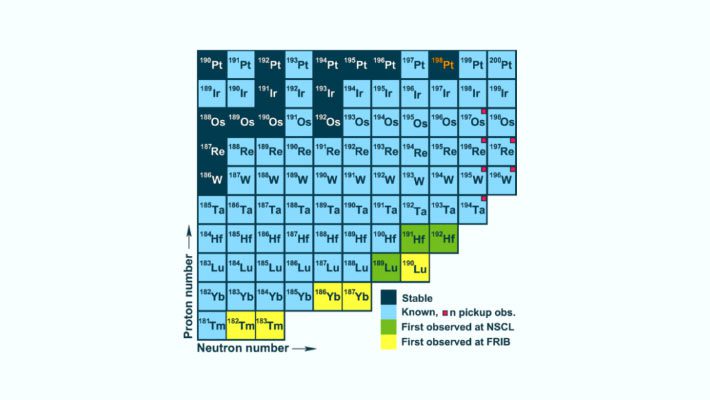Physicists using the Advanced Rare Isotope Separator (ARIS) at the Facility for Rare Isotope Beams (FRIB) have produced, separated, and identified five previously unknown isotopes: thulium-182, thulium-183, ytterbium-186, ytterbium-187 and lutetium-190. These new isotopes show that FRIB is nearing the creation of nuclear specimens that currently only exist when ultradense celestial bodies known as neutron stars crash into each other.
Region of the nuclear chart, 69<=Z<=78 and 112<=N<=122, showing the known nuclei and the eight nuclides that were recently discovered at NSCL and FRIB (present work) by the fragmentation of platinum-198 beams. Image credit: Tarasov et al., doi: 10.1103/PhysRevLett.132.072501.
“That’s the exciting part. We are confident we can get even closer to those nuclei that are important for astrophysics,” said Michigan State University’s Professor Alexandra Gade, scientific director of FRIB.
“This is probably the first time these isotopes have existed on the surface of the Earth,” added Michigan State University’s Professor Bradley Sherrill, head of the Advanced Rare Isotope Separator department at FRIB.
Our Sun is a cosmic atomic factory; it’s powerful enough to take the cores of two hydrogen atoms, or nuclei, and fuse them into one helium nucleus.
Hydrogen and helium are the first and lightest entries on the periodic table of the elements. Getting to the heavier elements on the table requires even more intense environments than what’s found in the Sun.
Astrophysicists hypothesize that elements like gold — about 200 times as massive as hydrogen — are created when two neutron stars merge.
Neutron stars are the leftover cores of exploded stars that were originally much larger than our Sun, but not so much larger that they can become black holes in their final acts.
Although they’re not black holes, neutron stars still cram an immense amount of mass into a very modest size.
“They’re about the size of Lansing (the capital of Michigan) with the mass of our Sun. It’s not certain, but people think that all of the gold on Earth was made in neutron star collisions,” Professor Sherrill said.
By making isotopes that are present at the site of a neutron star collision, physicists could better explore and understand the processes involved in making these heavy elements.
The five new isotopes — thulium-182, thulium-183, ytterbium-186, ytterbium-187 and lutetium-190 — are not part of that milieu, but they are the closest the scientists have come to reaching that special territory — and the outlook for finally reaching it is very good.
To create the new isotopes, the authors sent a beam of platinum-198 ions barreling into a carbon target. The beam current divided by the charge state was 50 nanoamps.
Since these experiments were performed, FRIB has already scaled its beam power up to 350 nanoamps and has plans to reach up to 15,000 nanoamps.
In the meantime, the new isotopes are exciting in and of themselves, presenting the nuclear research community new opportunities to step into the unknown.
“It’s not a big surprise that these isotopes exist, but now that we have them, we have colleagues who will be very interested in what we can measure next,” Professor Gade said.
“I’m already starting to think of what we can do next in terms of measuring their half-lives, their masses and other properties.”
“Researching these quantities in isotopes that have never been available before will help inform and refine our understanding of fundamental nuclear science.”
“There’s so much more to learn. And we’re on our way,” Professor Sherrill said.
The team’s results appear in the journal Physical Review Letters.
_____
O.B. Tarasov et al. 2024. Observation of New Isotopes in the Fragmentation of 198Pt at FRIB. Phys. Rev. Lett 132 (7): 072501; doi: 10.1103/PhysRevLett.132.072501
